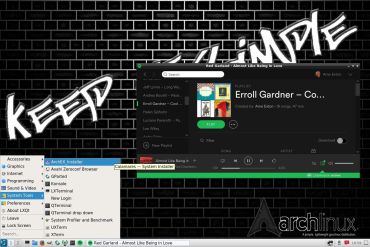 WHAT IS ArchEX?
WHAT IS ArchEX?
ArchEX 64 bit is a new (170327) Linux live DVD based on Arch Linux. Arch motto is KISS (Keep It Simple Stupid). ArchEX uses kernel 4.10.5-1-ARCH and the LXQt Desktop environment. LXQt is a lightweight Qt desktop environment. It will not get in your way. It will not hang or slow down your system. It is focused on being a classic desktop with a modern look and feel.
INSTALLED SOFTWARE
Among many other programs, Firefox, Gimp, GCC, Wicd and GParted – study this package LIST.
LOG IN to LXQt
When the boot process is ready you will end up as root (superuser) in console mode. Run the command startx to enter X and LXQt. If you want to install new packages through Yaourt you’ll have to run the command su live before yaourt MyNeededProgram. (You can’t run Yaourt as root).
INSTALLATION to hard drive
ArchEX can easily be installed to hard drive of those who so desire. Use ArchEX Installer (Calamares). I.e. while running ArchEX live from a DVD or USB stick. Read this INSTRUCTION and watch the slideshow below.
The Calamares Installer works almost perfect. You’ll have to install Grub (the boot loader) manually. See an example below when I have installed ArchEX in VirtualBox. Run the following commands after you have closed the Calamares Installer.
mkdir /mnt/sda1
mount /dev/sda1 /mnt/sda1
arch-chroot /mnt/sda1
grub-install /dev/sda
grub-mkconfig -o /boot/grub/grub.cfg
exit
Change the commands to suit your hard drive installation of ArchEX (if you need Grub).
Install ArchEX to a USB Pen Drive with persistence
Please read my INSTRUCTION. All your system changes will be saved directly on the stick.
Install ArchEX to a USB Pen Drive without persistence
Can be done with the dd-command in Linux. Please read this instruction. In Windows you can use Etcher. Watch this screenshot when Etcher is running.
Program Management in Arch Linux
Arch Linux uses a proprietary system called Pacman. It is similar to that found in CRUX Linux. Read about Pacman.
You can also read all the documentation on Arch Linux. Four commands are basically the only ones you need to use:
1) pacman -Sy (update the packages database)
2) pacman -Syu (upgrading the whole system)
3) pacman -S MyUsefulProgram (the package installation command)
4) pacman -R UnnecessaryProgram (uninstall a package).
Very simple!
Errors about archlinux-keyring
If you get errors about keys (for example key A634567E8t6574 could not be looked up remotely) when trying to upgrade your system you shall run the following four commands as root:
rm -R /etc/pacman.d/gnupg/
rm -R /root/.gnupg/
gpg –refresh-keys
pacman-key –init && pacman-key –populate archlinux
pacman-key –refresh-keys
Yaourt – Yet AnOther User Repository Tool
If you want to install certain special packages for example Google Chrome and Spotify you can/must install Yaourt. Study this tutorial about how to install and use Yaourt – a Pacman frontend. Note: Yaourt and Spotify are pre-installed in ArchEX Build 170327. If you want to install new packages through Yaourt you’ll have to run the command su live before yaourt MyNeededProgram. (You can’t run Yaourt as root).
LANGUAGE
The default locale/language is English. While installing ArchEX to hard drive, you can change the default locale to Swedish or any other language.
Rolling distribution
Arch Linux/ArchEX are rolling distributions, which implies that once you have installed the system on the hard drive there is no need for re-installations (which otherwise is common in the Linux world).
WHO should run Arch Linux?
My answer: The system fits the “advanced” Linux user/enthusiast, who would be willing to run an occasional command from time to time.
BENEFITS of ArchEX/Arch Linux
“Cutting Edge”-software and speed. You will for example always run the latest kernel if you upgrade ArchEX/Arch (for example) every month.
Screenshots
ArchEX LXQt Desktop
ArchEX starting up live
ArchEX starting up from hard drive (VirtualBox)
ArchEX Installer (Calamares) running
ArchEX (old) Installer running
DOWNLOAD
This build has been replaced by Build 170626.
RaspArch for Raspberry Pi 3 and Pi 2
RaspArch is a “remaster” of Arch Linux ARM. The original compressed system is of 231 MB. After I have added the LXDE Desktop environment, PulseAudio, Firefox, Yaourt and Gimp the system increased to 700 MB. RaspArch is a “ready-to-go” ARM system. It must be installed on a Raspberry Pi 3 or Raspberry Pi 2 computer.
A member on RaspEX recently wrote this about RaspArch: I’ve used Slackware, Debian, Gentoo, Ubuntu & Arch. I prefer Arch. Ubuntu is easier to install, Arch is easier to keep up to date. You do not go through big, painful, changes every year instead you just update, once in a while, make changes if instructed. Arch has most of the benefits of Gentoo without the pain of recompiling _everything_. When you do need to build a package in Arch its painless especially if you use one of the tools that support Aur (I like yaourt). Arch avoids the politics of Debian and Ubuntu and delivers a great Linux distribution. RaspArch now brings these advantages to the Pi 2.
Screenshot of RaspArch’s Desktop
Connect With Me
